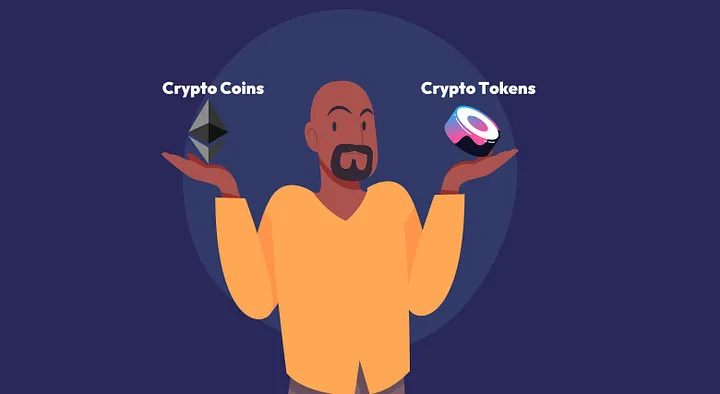If you’re new to crypto, mixing up some terminologies can be pretty easy. But that’s fine! It’s part of the never-ending learning process in the crypto space.
You’d be surprised to know that there are two very popular terminologies that are very often used interchangeably even though they actually have completely different meanings. Even veteran crypto users are guilty of doing this.
Crypto Coins & Crypto Tokens…
Did you know these two phrases mean completely different things both in design and mode of operation? Well, if you didn’t, you need to stick around and find out what makes them distinct.
I can guarantee that you’ll be amazed at how uniquely different they are, and you’ll also understand why they are very frequently mixed in statements and documentation alike.
Let’s begin!
Crypto Coins

Starting off with Crypto Coins, let’s take a moment to do some brainstorming.
Think about any blockchain you know of. There’s Solana whose native asset is SOL, there’s Ethereum whose native asset is Ether, Binance Smart Chain with the BNB asset, Cardano with ADA, and many more.
Now, all these native assets are all Crypto Coins. It’s that simple. The native asset of any blockchain is the blockchain’s Coin.
Now that’s a fundamental explanation, let’s dive deeper and look into their use cases to have a more robust understanding.
Use Cases of Crypto Coins
Coins such as Bitcoin are very well known to be a Store of Value and a Hedge against inflation from fiat currencies.
Others like XRP are used for Cross-border Payments, Litecoin for Day-to-Day Transactions, Monero for Financial Privacy, and more.
These coins all leverage the power of their respective blockchains to try to solve a specific real-world problem. But that’s not all…
Crypto Coins are also used as gas fees for their native blockchain and that’s a major reason why they usually have huge market caps due to their sheer importance to the operation of that chain.
We can notice that their purposes are usually pretty straightforward and modular. Now let’s look into Crypto Tokens.
Crypto Tokens

Tokens on the other hand, are a lot more dynamic than coins both in fundamentals and use case.
Tokens exist on pre-existing blockchains. Take Jupiter and Solana as an example. Jupiter’s native asset is known as JUP. Now since JUP is built on the pre-existing blockchain Solana, it is identified as a token.
So, its accurate to say that a blockchain may have just a single coin but could have thousands of tokens built on top of it.
Use Cases of Crypto Tokens
Looking deeper into the use cases of crypto tokens, they are mostly relevant in decentralized applications. They serve a specific purpose native to those applications such as voting rights, economic value, or a means to earn passive income (through staking/LPing).
They mainly incentivize interaction with the application and may be tied to more than one function at a time. For example, the JUP token on Jupiter is used for staking, governance and even to reward users for depositing into liquidity pools.
Did you know that in recent times, tokens are even used for asset tokenization? Now tokenization could be performed on anything including physical assets like real estate and this means tokens have a much more flexible utility with near-endless possibilities when compared to their Coin counterparts.
Conclusion

So. if we think about it objectively, it’s pretty safe to say that all coins may be considered as tokens. But not all tokens are considered as coins.
While they both mean different things and have different purposes, there may still be some mid-ground between the two. Hence, the reason why they are so frequently used interchangeably.





